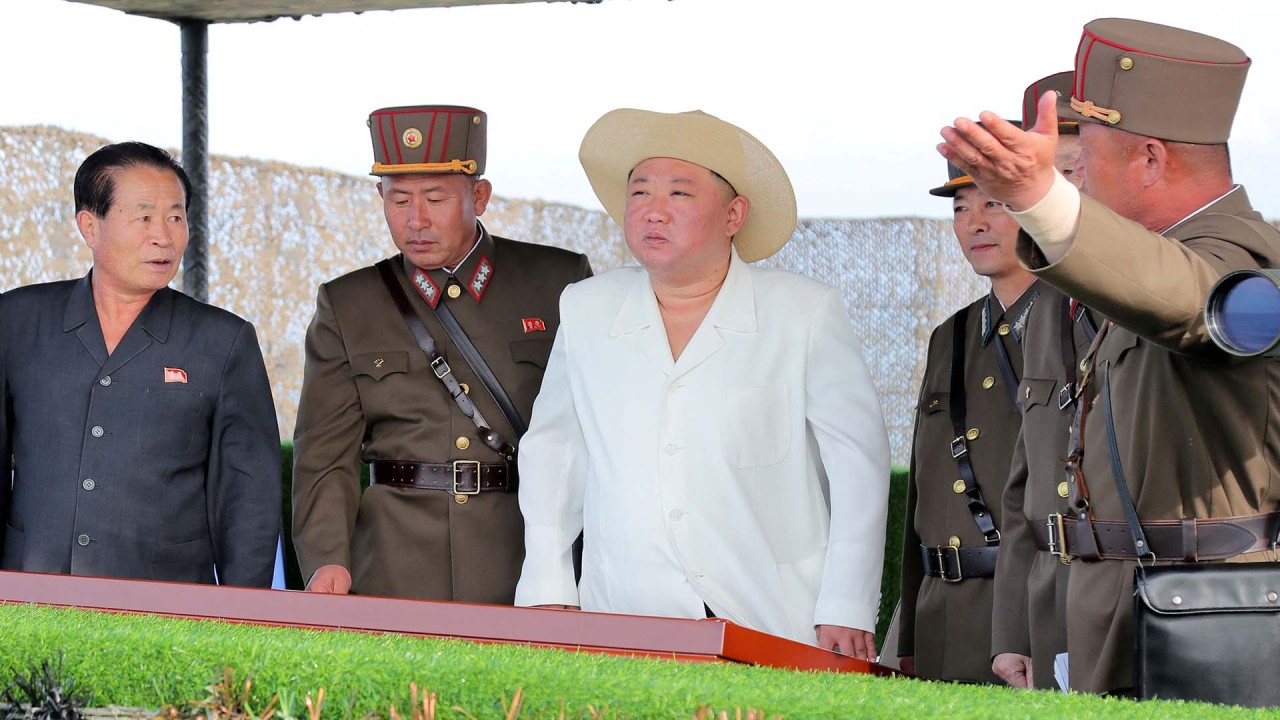
Warning shots fired at inter-Korean border as military tensions flare
- North Korea said its artillery launches on Monday were in response to the South firing at a merchant ship off the peninsula’s west coast
- Their poorly marked sea boundary is a source of long-running skirmishes and violence, including two attacks in 2010 that killed 50 people
North Korea’s military said its coastal defence units responded by firing 10 rounds of artillery warning shots towards its territorial waters, where “naval enemy movement was detected”. It accused a South Korean naval ship of intruding into North Korean waters on the pretext of cracking down on an unidentified ship.

There were no reports of fighting, but the sea boundary off the Korean peninsula’s west coast is a source of long-running animosities.
The American-led UN command drew a boundary at the end of the 1950-53 Korean war, but North Korea insists upon a boundary that encroaches deeply into waters controlled by the South.
Among the deadly events that have happened in the area are the North’s shelling of a South Korean island and its alleged torpedoing of a South Korean navy ship, both in 2010. The two attacks killed 50 South Koreans.
Cheong Seong-chang, a senior analyst at the Sejong Institute think tank, said it was unimaginable for a North Korean merchant vessel to have crossed the de facto maritime border between the two rivals without being instructed to do so.
“Therefore, it is highly likely that the North had plotted his incident”, he said.
Monday’s exchange of fire highlights the absence of an agreement on a clearly marked sea border, save for the one that was unilaterally drawn by the UN at the end of the Korean war to prevent armed clashes between the two rivals, Cheong said.
“North Korea, emboldened by its recent development of tactical nuclear weapons, is expected to continue attempting to rescind the NLL which it believes has been drawn to its disadvantage”, Cheong said, referring to the de facto border that’s known as the Northern Limit Line.
The South’s military must be put on alert to prevent the recurrence of naval clashes
He said North Korea thinks of the current moment as a golden opportunity to revoke the NLL, thanks to mounting rivalry between China and Russia on one side and the US and its allies on the other.
“Therefore, the South’s military must be put on alert to prevent the recurrence of the naval clashes in the Yellow Sea or the shelling of Yeonpyeong island”, he said in reference to the 2010 artillery attack on the South Korean island.
Professor Yang Moo-jin of the University of North Korean Studies said it was “disconcerting” that the two sides had resumed arguing over a breach of ill-defined sea borders.
The two Koreas signed an agreement at the 2018 inter-Korean summit that was intended to prevent military confrontation, setting up buffer zones based on the already-existing military demarcation line – although the North still insists that the NLL is unjust under international law.
“The sea borders in the Yellow Sea are a hotspot where soldiers of both sides are always on high alert. If tensions like this continue and the soldiers have had it, they are exposed to the risks of accidental shooting incidents, sparking armed clashes between the two rivals”, Yang said.

Some observers say North Korea could extend its spate of testing or launch provocations near the western sea border as the South Korean and US continue their combined military exercises.
In its Monday statement, the General Staff of the North’s Korean People’s Army accused South Korea of provoking animosity near their land border as well with its own artillery tests and propaganda loudspeaker broadcasts. South Korea has already confirmed it performed artillery firings last week as part of its regular military exercises, but didn’t immediately respond to the North’s claim on the loudspeaker broadcasts.

“The KPA General Staff once again sends a grave warning to the enemies who made even naval intrusion in the wake of such provocations as the recent artillery firing and loudspeaker broadcasting on the ground front,” the North’s statement said.
In 2018, the two Koreas dismantled huge loudspeakers used to blare Cold War-style propaganda across their tense border as part of their reconciliation steps at the start of the now-dormant nuclear diplomacy between Pyongyang and Washington. If South Korea had restarted its propaganda broadcasts, that could trigger a strong North Korean response as it was previously extremely sensitive to South Korean broadcasts of criticism of its human rights situation, world news and K-pop songs. Most of North Korea’s 26 million people have no official access to foreign TV and radio programmes.
“Pyongyang’s politics of blaming external threats and projecting confidence in military capabilities can motivate greater risk taking,” said Leif-Eric Easley, a professor at Ewha University in Seoul. “North Korean probing of South Korean perimeter defences could lead to a serious exchange of fire and unintended escalation.”
Since September 25, North Korea has fired 15 missiles and hundreds of artillery shells toward the sea.
Seoul and Washington routinely conduct military drills to maintain their readiness against potential North Korean aggression. The allies say their drills are defensive in nature, but North Korea views them as an invasion rehearsal.
South Korea‘s military is undergoing annual field exercises set to end this Friday. This year’s drills involve an unspecified number of US troops.
Next week, South Korea and the US are to hold joint air force drills involving some 240 warplanes, including F-35 fighters operated by both nations. The drills are aimed at inspecting the two countries’ joint operation capabilities and improve combat readiness, the South Korean military said on Tuesday.
Additional reporting by Park Chan-kyong


